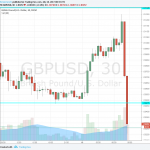The US dollar’s upside correction that began before the weekend has been extended in Asia and Europe today. The main exception is the Japanese yen.The yen’s modest gains have been registered despite the firmness in US rates and continued advance in equities; both factors associated with a weaker Japanese currency.
It seems two other considerations are offsetting the traditional drivers. First, there is unwinding of long euro short yen positions that had been established. The euro had rallied from JPY132 in the middle of December to nearly JPY136.65 at the end of last week before posting a bearish shooting star candlestick pattern. It is now nearing chart support seen near JPY134.35-JPY134.45, which corresponds to a 50% retracement of the three-week rally, the 20-day moving average, and previous congestion.

The second consideration today is the BOJ’s decision to reduce the buying of long-dated bonds (10-25 years) by JPY10 bln to JPY190 bln. It is the first reduction since 2016. The BOJ’s yield curve targeting strategy has required it to buy few JGBs that the JPY80 trillion declaratory objective. This seems more like a technical adjustment that a substantive policy change. Many who look for the BOJ to adjust policy this year anticipate a higher target for the 10-year JGB.
There was another important announcement in Asia. It was from the PBOC and it regards how the yuan’s reference rate is set. Last year, officials had introduced a “counter-cyclical” component to ostensibly dampen the volatility and downside pressure. Previously the “fix” was said to be determined by the previous day’s close, subsequent movement against a basket of currencies and this counter-cyclical element that was meant to offset sentiment and “herd” behavior. This added an unknown (that could not be quantified) into the mix, making the process less transparent, but apparently giving officials the tool to resist market pressure.Officials said that the “counter-cyclical” component has been dropped.













Leave A Comment